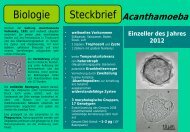Paramecium - Deutsche Gesellschaft für Protozoologie / German ...
Paramecium - Deutsche Gesellschaft für Protozoologie / German ...
Paramecium - Deutsche Gesellschaft für Protozoologie / German ...
You also want an ePaper? Increase the reach of your titles
YUMPU automatically turns print PDFs into web optimized ePapers that Google loves.
Conjugation in the Spirotrich Ciliate Halteria grandinella<br />
(Müller, 1773) Dujardin, 1841 (Protozoa, Ciliophora)<br />
Sabine Agatha, Wilhelm Foissner<br />
Dept. Organismal Biology, Univ. Salzburg<br />
The isogamontic conjugants fuse partially with their ventral sides to a<br />
homopolar pair. The first maturation division embraces dramatic<br />
transformations: (i) the partners obtain an intimate interlocking<br />
arrangement; (ii) the number of bristle kineties is reduced from 7 to 4<br />
in each partner; and (iii) the right conjugant loses its buccal membranelles,<br />
the left the whole adoral zone. The remaining collar membranelles<br />
arrange around the pair’s anterior end and are shared by both<br />
partners; finally, the couple resembles a vegetative specimen in size<br />
and outline. The vegetative macronucleus fragments before pycnosis.<br />
The micronucleus performs three maturation divisions, but only one<br />
derivative each performs the second and third division. The synkaryon<br />
divides twice, producing the future micronucleus, a macronuclear<br />
anlage, and two disintegrating derivatives. Scattered somatic<br />
kinetids occur, but disappear without reorganization. An incomplete<br />
oral primordium originates on the ventral side of both partners. The<br />
conjugation of Halteria resembles in several respects that of spirotrich<br />
hypotrichs; however, the majority of morphological, ontogenetical,<br />
and ultrastructural features still indicates an affiliation with the<br />
oligotrich and choreotrich spirotrichs. Accordingly, the cladistic analysis<br />
still contradicts the genealogies based on the sequence of the<br />
small subunit rRNA genes. Supported by the Austrian Science Foundation<br />
(Projects P17752-B06 and P19699-B17).<br />
sabine.agatha@sbg.ac.at<br />
wilhelm.foissner@sbg.ac.at<br />
61





